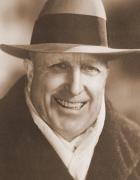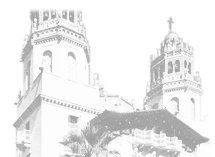
William Randolph Hearst, the man who conceived Hearst Castle, was a media genius whose influence extended to publishing, politics, Hollywood, the art world and everyday American life. His power and vision allowed him to pursue one of the most ambitious architectural endeavors in American history, the result of which can be seen in magnificent grounds and structures of Hearst Castle.
Mr. Hearst was born on April 29, 1863, in San Francisco, California, as the only child of George and Phoebe Hearst. His father, a wealthy man as a result of relentless work and creativity in his various mining interests, allowed young William the opportunity to see and experience the world as few do.
At the age of ten Hearst toured Europe with his mother. Inspiration rose from the grandeur and scale of castles, art and history. This experience fueled Hearst’s life long aspiration to recreate this majesty for his own enjoyment. Back in the United States, Hearst was enrolled in St. Paul’s Preparatory School in Concord, New Hampshire at the age of 16. Hearst continued his education at Harvard where he showed the first signs of becoming a future publishing tycoon. At Harvard, he excelled in journalism and acted as the business manager of the Harvard Lampoon. His election to the “Hasty Pudding” theatrical group revealed his talent and interest in drama.
During his time at Harvard, his father George acquired the San Francisco Examiner as payment for a gambling debt. Soon after, the young Hearst pleaded with his father to turn over the paper to him. In 1887 the older Hearst relented and relinquished control to his ambitious son. Shortly after, William Randolph Hearst purchased another newspaper, the New York Journal, which would become the second in a long list of newspaper holdings that he acquired in the next decade of his life. At his peak he owned more than two dozen newspapers nationwide; in fact, nearly one in four Americans got their news from a Hearst paper.
In 1903, Mr. Hearst married Millicent Willson in New York City. The couple had five sons together during their marriage: George, William Randolph Jr., John and twins Randolph and David.
Their honeymoon drive across the European continent inspired Mr. Hearst to launch his first magazine, Motor. Motor became the foundation for another publishing endeavor that is still known as Hearst Magazines.
Hearst’s interest in politics led him to election to the United States House of Representatives as a Congressman from New York in 1902. After reelection in 1904, he unsuccessfully pursued the New York Governorship in 1906.
In the 1920s he started one of the first print-media companies to enter radio broadcasting. Mr. Hearst was a major producer of movie newsreels with his company Hearst Metrotone News, and is widely credited with creating the comic strip syndication business. His King Features Syndicate today is the largest distributor of comics and text features in the world. In his career, William Hearst produced over 100 films including, “The Perils of Pauline,” “The Exploits of Elaine” and “The Mysteries of Myra.” In the 1940s he was an early pioneer of television.
In addition to his brilliant business endeavors, Mr. Hearst amassed a vast and impressive art collection that included American and European Old Master paintings and sculptures, tapestries, oriental rugs, Greek, Roman and Egyptian antiquities, silver, furniture and historic ceilings. Much of this collection found its home at Hearst Castle and five other sumptuous properties, while the remainder filled warehouses on both the East and West Coasts. Like many of his contemporaries, Hearst voraciously collected art and established a museum quality collection.
Throughout his life, Hearst dreamed of building a dwelling similar to those he had seen on his European tour as a boy. Hearst Castle was to become the realization of this dream as he and architect Julia Morgan collaborated for 28 years to construct a castle worthy of those he saw in Europe. During construction Hearst used the Castle as his primary residence, and it was here that he continually entertained the elite of Hollywood, politics and sports. Hearst left his San Simeon estate in 1947 to seek medical care unavailable in the remote location. While the Castle was never completely finished, it stands as the remarkable achievement of one man’s dream.
William Randolph Hearst died in Beverly Hills on August 14, 1951, at the age of 88. He was interred in the Hearst family mausoleum at the Cypress Lawn Cemetery in Colma, California. All of his sons followed their father into the media business and his namesake, William Randolph, Jr., became a Pulitzer Prize-winning Hearst newspaper reporter.
Properties owned
- Babicora, a one-million acre cattle ranch in Chihuahua, Mexico
- 270,000 acres at San Simeon, California
- Wyntoon, a 67,000 acre estate on the McCloud River in Northern California
- St. Donat’s Castle in Wales
- Commercial and residential property throughout the United States, including Santa Monica and New York


